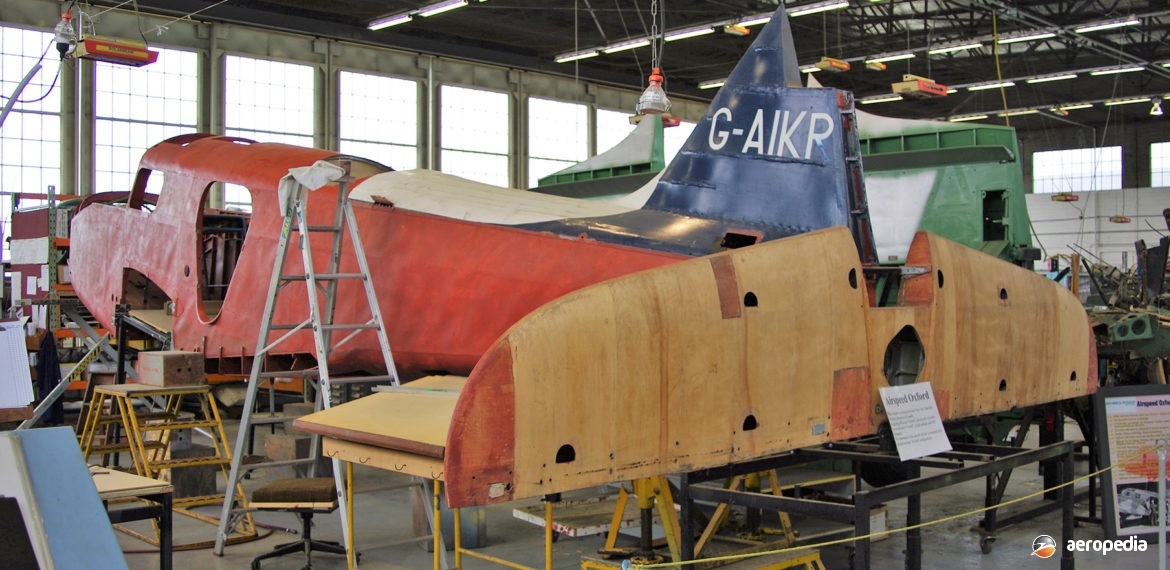Photograph:
Airspeed Consul G-AIKR (c/n 4338) under restoration at Wigram NZ in April 2009 (David C Eyre)
Country of origin:
United Kingdom
Description:
Commercial transport
Power Plant:
Two 295-kw (395-hp) Armstrong Siddeley Cheetah X seven-cylinder radial air-cooled
engines
Specifications:
- Wingspan: 16.27 m (53 ft 4 in)
- Length: 10.85 m (35 ft 6 in)
- Wing area: 32.3 m² (348 sq ft)
- Max speed: 306 km/h (190 mph)
- Max cruising speed: 262 km/h (163 mph)
- Economical Cruising speed: 233 km/h (145 mph)
- Service ceiling: 5,791 m (19,000 ft)
- Max range: 1,448 km (900 miles)
- Empty weight: 2,722 kg (6,000 lb)
- Loaded weight: 3,742 kg (8,250 lb)
History:
The Airpeed AS-65 Consul was a conversion of the Airspeed Oxford for civil use by Airspeed Ltd of Portsmouth, and a total of 161 aircraft was produced. The first aircraft (G-AGVY – ex V3679 – c/n 3204) was a de Havilland-built Oxford converted for civil work, receiving its Certificate of Airworthiness on 15 March 1946.
Intended to be cheap to buy and operate, Airspeed purchased Oxfords from the RAF, or converted incomplete aircraft on the production line. Engine installed were the 295 kw (395 hp) Armstrong Siddeley Cheetah X and accommodation was provided for a crew of two and five passengers. An ambulance variant was able to carry two stretchers on the starboard side, one above the other, and there was a large upward-opening door on the port side. The nose was lengthened to provide baggage space for 68 kg (150 lb).
The Consul saw extensive service in the UK with Chartair (9 examples), Morton Air Services Ltd (8) Westminster Airways (7), Air Enterprises (7), British Air Services (5), Lancashire Aircraft Corp (6) etc. The type was also operated by SITA in Saigon, Air Jordan, Aer Lingus, Iberia, Union of Burma, East African and Malayan.
The consul saw service with the RNZAF. From 1944 large numbers of Oxfords were placed in storage at Woodbourne and by 1947 112 of these had been disposed of. However, by the 1950s, as they were constructed of wood and suffering from storage in the open, they were disposed of.
Six examples of the Airspeed Oxford were converted to Consul standard (NZ1901- c/n 4011 ex NZ2157; NZ1902 – c/n 3927 – ex NZ2153 and PG940 [RAF serial]; NZ1903 – c/n 3587 – ex NZ2135; NZ1904 ex NZ1392; NZ1905 – c/n 3036 – ex NZ1394; and NZ1906 – c/n 1125 – ex NZ2119) by de Havilland New Zealand between 1948 and 1952 and they saw service in the communications, light freight and transport roles until 1954 when the survivors were sold for scrap and broken up in March that year. One (NZ1902) crashed in bad weather at about 2,743 m (9,000 ft) near the crater of Mt Ruapehu on 11 December 1951.
A couple of examples survive in museums. One example operated by Malayan Airways from 1947 survives. This company later became Singapore Airlines in 1965. This aircraft (4X-AEK – c/n 4324 – ex TJ187, G-ALKI) was obtained by the airline from the RAF Museum and was rebuilt for display by airline staff. However, further deterioration occurred over the years to the wooden structure which meant further restoration work was needed to be performed and the aircraft was transported to the Croydon Aeroplane Company at Mandeville, NZ in 2004 for complete restoration.
In mid 2004 an example G-AIKR (c/n 4338) was shipped to New Zealand to be converted back to Oxford configuration and when completed it became part of the collection of the RNZAF Museum at Wigram

